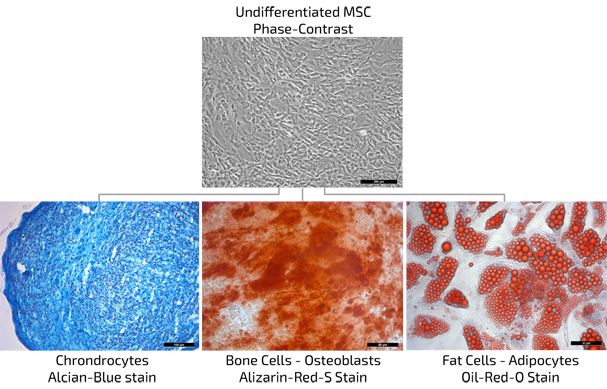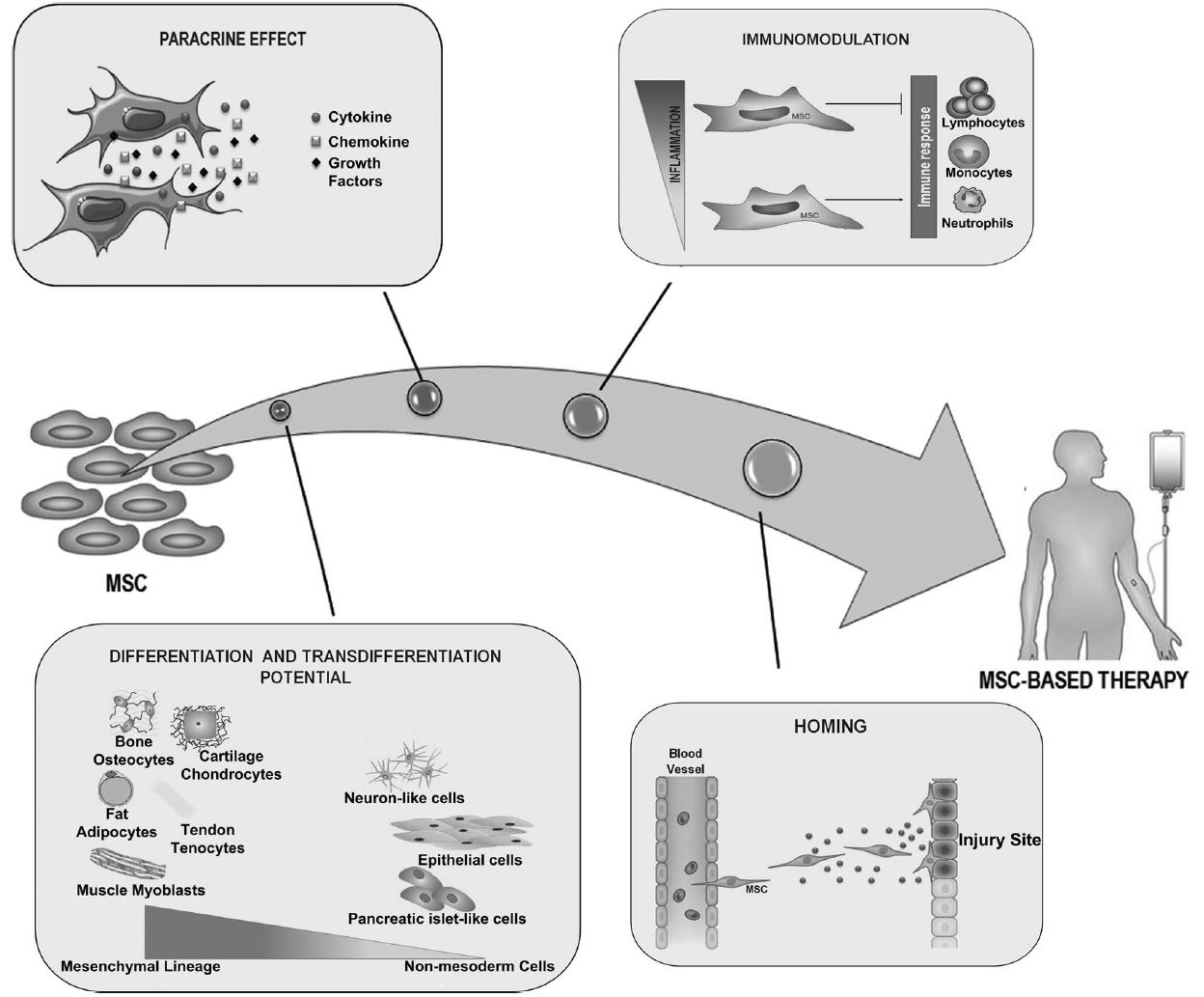间充质干细胞 (MSC) 是最著名的医学干细胞类型之一。它们已被证明对范围广泛的疾病有效,而且风险很小。
与此同时,数百项临床研究正在进行中,以更详细地研究它们的再生能力。从生物学的角度来看,它们是结缔组织的祖细胞。这意味着它们对于建立和维持全身结缔组织的健康状态很重要,被称为基质干细胞。
同样,它们具有分化成一系列其他细胞类型的能力,包括软骨细胞(软骨细胞)、成骨细胞(骨细胞)、脂肪细胞(脂肪细胞)等。这种特性将它们归类为“多能干细胞”(能够转化为多种细胞类型)。
为什么间充质干细胞具有如此大的治疗潜力?

为什么MSEC-间充质干细胞-与其他干细胞类型相比更常用
它们之所以成为医学应用和人体临床试验中的主要干细胞类型,有以下几个原因:
- 它们相对容易收获并与以下隔离:
- 脂肪组织,称为adMSC(脂肪来源的 MSC)
- 骨髓,称为bmMSCs(骨髓间充质干细胞)
- 脐带,称为ucMSC(脐带间充质干细胞)
- MSC在实验室培养和扩增相对稳定
- 它们可以经历相对较多的分裂周期而不会失去表达谱、健康和分裂潜能
- 为各种疾病模型收集的大量动物、临床和科学数据,包括神经退行性疾病
- 它们几乎没有生长成癌细胞的潜力
- 正如最近的研究所揭示的那样,它们的干细胞分泌蛋白组特征非常有益,因为它对身体显示出广泛的再生和保护能力
- 因此,MSC是我们制造干细胞分泌疗法的最佳来源。
从脂肪组织中分离出的间充质干细胞
脂肪组织含有相对高浓度的间充质干细胞。通过酶法或显微镜去除非细胞部分来处理组织。这种细胞终产物称为基质血管分数 (SVF)。用SVF治疗可以有效治疗某些区域和疾病。然而,它包含的MSC数量是有限的。MSC的扩增(在实验室中增加它们的细胞计数)相对简单。然而,这个过程极大地复杂化了临床应用,因为它也会影响风险状况。由于这个事实,这个过程在所有发达国家都受到高度限制。获得更多MSC 的好处与获得高细胞数无关,而是与它们的活力和分泌情况有关。

为什么间充质干细胞具有如此大的治疗潜力?

如1) 分化成各种细胞谱系的能力,
2) 分泌旁分泌因子以启动周围细胞愈合和再生的能力,
3) 减少炎症和调节免疫反应的能力,
4) 迁移到准确损伤部位的能力。图来自 [10]。
参考资料:
- Gu W, Zhang F, Xue Q, Ma Z, Lu P, Yu B. Transplantation of bone marrow mesenchymal stem cells reduces lesion volume and induces axonal regrowth of injured spinal cord. Neuropathology. 2010; 30: 205-217.
- Wilkins A, Kemp K, Ginty M, Hares K, Mallam E, Scolding N. Human bone marrow-derived mesenchymal stem cells secrete brain-derived neurotrophic factor which promotes neuronal survival in vitro. Stem Cell Res. 2009; 3: 6370
- Wei X, Yang X, Han ZP, Qu FF, Shao L, Shi YF. Mesenchymal stem cells: a new trend for cell therapy. Acta Pharmacol Sin. 2013; 34: 747-754.
- Wang S, Qu X, Zhao RC. Clinical applications of mesenchymal stem cells. J Hematol Oncol. 2014; 5: 19.
- Farini, Andrea, et al. “Clinical applications of mesenchymal stem cells in chronic diseases.” Stem cells international 2014 (2014).
- Volarevic, Vladislav, et al. “Concise review: therapeutic potential of mesenchymal stem cells for the treatment of acute liver failure and cirrhosis.” Stem Cells 32.11 (2014): 2818-2823.
- Ikebe, Chiho, and Ken Suzuki. “Mesenchymal stem cells for regenerative therapy: optimization of cell preparation protocols.” BioMed research international 2014 (2014).
- Sharma, Ratti Ram, et al. “Mesenchymal stem or stromal cells: a review of clinical applications and manufacturing practices.” Transfusion 54.5 (2014): 1418-1437.
- Jo, Chris Hyunchul, et al. “Intra‐articular injection of mesenchymal stem cells for the treatment of osteoarthritis of the knee: a proof‐of‐concept clinical trial.” Stem cells 32.5 (2014): 1254-1266.
- Squillaro, Tiziana, Gianfranco Peluso, and Umberto Galderisi. “Clinical trials with mesenchymal stem cells: an update.” Cell transplantation 25.5 (2016): 829-848.
- Orozco, Lluis, et al. “Treatment of knee osteoarthritis with autologous mesenchymal stem cells: two-year follow-up results.” Transplantation 97.11 (2014): e66-e68.
- Filardo, Giuseppe, et al. “Mesenchymal stem cells for the treatment of cartilage lesions: from preclinical findings to clinical application in orthopaedics.” Knee surgery, sports traumatology, arthroscopy 21.8 (2013): 1717-1729.
- Jo, Chris Hyunchul, et al. “Intra‐articular injection of mesenchymal stem cells for the treatment of osteoarthritis of the knee: a proof‐of‐concept clinical trial.” Stem cells 32.5 (2014): 1254-1266.
- Vangsness, C. Thomas, et al. “Adult human mesenchymal stem cells delivered via intra-articular injection to the knee following partial medial meniscectomy.” J Bone Joint Surg Am 96.2 (2014): 90-98.
- Pires A.O., Mendes-Pinheiro B., Teixeira F.G., Anjo S.I., Ribeiro-Samy S., Gomes E.D., Serra S.C., Silva N.A., Manadas B., Sousa N., et al. Unveiling the Differences of Secretome of Human Bone Marrow Mesenchymal Stem Cells, Adipose Tissue-Derived Stem Cells, and Human Umbilical Cord Perivascular Cells: A Proteomic Analysis. Stem Cells Dev. 2016;25:1073–1083. doi: 10.1089/scd.2016.0048.
免责说明:本文仅用于传播科普知识,分享行业观点,不构成任何临床诊断建议!杭吉干细胞不保证信息的准确性和完整性。所发布的信息不能替代医生或药剂师的专业建议。如有版权等疑问,请随时联系我。




 浙公网安备 33010202002429号
浙公网安备 33010202002429号 官方微信公众号
官方微信公众号